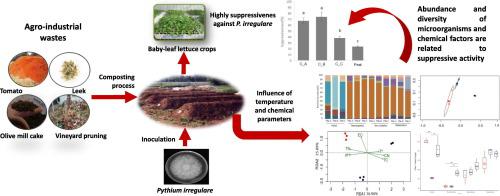Science of the Total Environment ( IF 8.2 ) Pub Date : 2021-09-17 , DOI: 10.1016/j.scitotenv.2021.150330 Alicia Hernández-Lara 1 , Margarita Ros 1 , Jessica Cuartero 1 , María Ángeles Bustamante 2 , Raul Moral 2 , Francisco Javier Andreu-Rodríguez 2 , Juan A Fernández 3 , Catalina Egea-Gilabert 3 , José Antonio Pascual 1

|
Composting is an advantageous and efficient process for recycling organic waste and producing organic fertilizers, and many kinds of microorganisms are involved in obtaining quality compost with suppressive activity against soil-borne pathogens. The aim of this work was to evaluate the main differences in the effects of three composting piles on the whole bacterial and fungal communities of baby-leaf lettuce crops and to determine the specific communities by high-throughput sequencing related to suppressiveness against the soil-borne plant pathogen Pythium irregulare- (P. irregulare). Compost pile A was composed of 47% vineyard pruning waste, 34% tomato waste and 19% leek waste; pile B was composed of 54% vineyard pruning waste and 46% tomato waste; and pile C was composed of 42% vineyard pruning waste, 25% tomato waste and 33% olive mill cake. The temperature and the chemical properties of the piles were monitored throughout the composting process. In addition, the potential suppressive capacity of the three composts (C_A, C_B and C_C) against P. irregulare in baby-leaf lettuce was assessed. We found that the bacterial community changed according to the composting phases and composting pile and was sensitive to chemical changes throughout the composting process. The fungal community, on the other hand, did not change between the composting piles and proved to be less influenced by chemical properties, but it did change, principally, according to the composting phases. All composts obtained were considered stable and mature, while compost C_C showed higher maturity than composts C_A and C_B. During composting, the three piles contained a greater relative abundance of Bacterioidetes, Proteobacterias and Actinobacterias related to the suppression of soil-borne pathogens such as Pythium irregulare. Composts C_A and C_B, however, showed higher suppressiveness against P. irregulare than compost C_C. Deeper study showed that this observed suppressiveness was favored by a higher abundance of genera that have been described as potential suppressive against P. irregulare, such as Aspergillus, Penicillium, Truepera and Luteimonas.
中文翻译:

农工业废物堆肥不同阶段的细菌和真菌群落动态及其与堆肥抑制的关系
堆肥是回收有机废物和生产有机肥料的一种有利且有效的过程,多种微生物参与获得对土壤传播的病原体具有抑制活性的优质堆肥。这项工作的目的是评估三个堆肥堆对小叶生菜作物整个细菌和真菌群落的影响的主要差异,并通过与土壤传播抑制相关的高通量测序确定特定群落。植物病原体不规则腐霉- ( P.不规则)。堆肥堆 A 由 47% 的葡萄园修剪废料、34% 的番茄废料和 19% 的韭葱废料组成;B 堆由 54% 的葡萄园修剪废料和 46% 的番茄废料组成;C 堆由 42% 的葡萄园修剪废料、25% 的番茄废料和 33% 的橄榄磨饼组成。在整个堆肥过程中监测堆的温度和化学性质。此外,三种堆肥(C_A、C_B 和 C_C)对不规则假单胞菌的潜在抑制能力在婴儿叶生菜中进行了评估。我们发现细菌群落根据堆肥阶段和堆肥堆而发生变化,并且对整个堆肥过程中的化学变化很敏感。另一方面,真菌群落在堆肥堆之间没有变化,并且被证明受化学性质的影响较小,但它确实发生了变化,主要是根据堆肥阶段。获得的所有堆肥都被认为是稳定和成熟的,而堆肥 C_C 显示出比堆肥 C_A 和 C_B 更高的成熟度。在堆肥过程中,三个堆中的拟杆菌、变形菌和放线菌相对丰度更高,这与抑制不规则腐霉等土传病原体有关. 然而,与堆肥 C_C 相比,堆肥 C_A 和 C_B 对不规则假单胞菌表现出更高的抑制作用。更深的研究表明,观察到的这suppressiveness用较高丰度的已被描述为针对潜在抑制属的青睐P.不规则型,如曲霉属,青霉属,Truepera和Luteimonas。











































 京公网安备 11010802027423号
京公网安备 11010802027423号